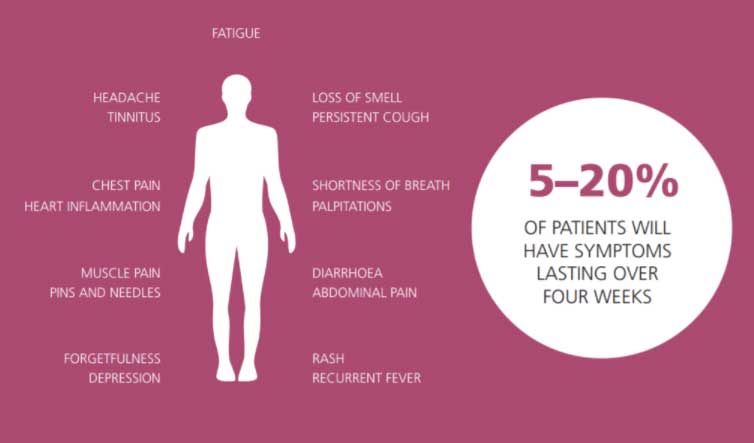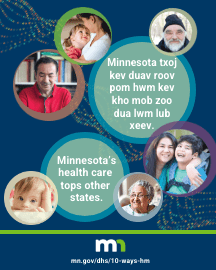About Long COVID
From Minnesota Department of Health
Although most people with COVID-19 will get better after a few weeks, some do not fully recover from their illness. Post-COVID conditions are health problems that people experience four or more weeks after being infected with the virus that causes COVID-19. Symptoms can be new, returning, or ongoing. They can last for months or longer and range from mild to debilitating.
Post-COVID conditions are also called long COVID, long-haul COVID, chronic COVID, post-acute COVID, or post-acute sequelae of COVID-19 (PASC). While there may be differences and overlap between conditions, many people simply refer to these ongoing health problems as “long COVID.”
Some people with long COVID may face challenges returning to work, school, and other activities that allow them to thrive. As of July 2021, long COVID and post-COVID conditions can be considered a disability under the Americans with Disabilities Act (ADA).
What We Know About Long COVID
There is still a lot to learn about COVID-19 and long COVID. MDH, the Centers for Disease Control and Prevention (CDC), and researchers around the world are working to understand the short- and long-term effects of COVID-19, who is most at risk for developing long COVID, and how to prevent, diagnose, treat, and track post-COVID conditions.
Who Can Get Long COVID
Anyone who has been infected with the virus that causes COVID-19 can develop long COVID, including children. While some post-COVID conditions are more common in people who experienced severe illness or hospitalization from COVID-19, long COVID can also happen to people whose initial infection was mild or without symptoms. We are still learning how common long COVID is, but studies show that 10-30% or more of people who have COVID could have symptoms for months or longer after their initial infection.
Children and young adults may also be more susceptible to a very rare, but serious post-COVID condition called Multisystem Inflammatory Syndrome in Children (MIS-C).
For more information about the range of post-COVID conditions, including those associated with hospitalization and intensive care, visit CDC: Post-COVID Conditions.
Symptoms
Long COVID can affect many different systems of the body. Sometimes symptoms get worse after physical or mental activities. People with long COVID report experiencing different severities and combinations of the following:
- Difficulty breathing or shortness of breath
- Tiredness or fatigue
- Difficulty thinking, concentrating, or remembering (sometimes called “brain fog”)
- Cough
- Chest pain
- Stomach pain
- Headache
- Fast-beating or pounding heart (also known as heart palpitations)
- Joint or muscle pain
- Pins-and-needles feeling
- Diarrhea
- Sleep problems
- Fever
- Dizziness or lightheadedness on standing
- Skin issues like rash or hair loss
- Mood changes, including depression or anxiety
- Changes in sense of smell or taste
- Changes in menstrual period cycles
Diagnosis and Treatment
There is no single test that can diagnose long COVID itself, but doctors may order a variety of tests to better understand symptoms or to rule out other possible causes. They may also ask about a patient’s history of COVID-19 infection and underlying medical conditions.
Currently there is no cure for long COVID, but health care providers may be able to help reduce or manage symptoms through rehabilitation services, medications, and coordinated care. Treatment may include specialists that focus on the heart, lungs, digestion, diet and nutrition, mental health, neurology, physical therapy, or other fields of medicine.
Some people with long COVID receive a diagnosis of myalgic encephalomyelitis/chronic fatigue syndrome (ME/CFS), postural orthostatic tachycardia syndrome (POTS), dysautonomia, fibromyalgia, or other health conditions. Medical specialists may be able to apply the same treatments and therapies for known conditions to help people with long COVID.
Some people may find that their long COVID symptoms improve over time. We are not yet sure if long COVID symptoms could be permanent or irreversible in some people.
Prevention
The best way to prevent long COVID and post-COVID conditions is to avoid getting infected with the virus that causes COVID-19. The more steps you take to protect yourself, the safer you will be.
Vaccination is the best way to reduce your chances of infection. Visit Find COVID-19 vaccine locations to sign up for a free COVID-19 vaccine at a nearby clinic, hospital, pharmacy, or community site.
Because no single step on its own is perfect at preventing COVID-19, the safest thing to do is layer prevention measures when you can. Visit Protect Yourself & Others: COVID-19 to learn more about preventing the spread of COVID-19.
























